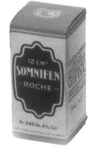The history of barbiturates a century after their clinical introduction
- PMID: 18568113
- PMCID: PMC2424120
The history of barbiturates a century after their clinical introduction
Abstract
The present work offers an analysis of the historical development of the discovery and use of barbiturates in the field of psychiatry and neurology, a century after their clinical introduction. Beginning with the synthesis of malonylurea by von Baeyer in 1864, and up to the decline of barbiturate therapy in the 1960s, it describes the discovery of the sedative properties of barbital, by von Mering and Fischer (1903), the subsequent synthesis of phenobarbital by this same group (1911), and the gradual clinical incorporation of different barbiturates (butobarbital, amobarbital, secobarbital, pentobarbital, thiopental, etc). We describe the role played in therapy by barbiturates throughout their history: their traditional use as sedative and hypnotic agents, their use with schizophrenic patients in so-called "sleep cures" (Klaesi, Cloetta), the discovery of the antiepileptic properties of phenobarbital (Hauptmann) and their use in the treatment of epilepsy, and the introduction of thiobarbiturates in intravenous anesthesia (Lundy, Waters). We also analyze, from the historical perspective, the problems of safety (phenomena of dependence and death by overdose) which, accompanied by the introduction of a range of psychoactive drugs in the 1950s, brought an end to barbiturate use, except in specific applications, such as the induction of anesthesia and the treatment of certain types of epileptic crisis.
Keywords: anesthesia; barbiturates; epilepsy; history of medicine; sedative-hypnotic drugs; “sleep cures”.
Figures








References
-
- Adams RC. Intravenous anesthesia. New York: Hoeber; 1944.
-
- Alamo C, López-Muñoz F, Echániz T, et al. Fármacos ansiolíticos, sedantes e hipnóticos. In: López-Muñoz F, Alamo C, editors. Historia de la Neuropsicofarmacología. Una nueva aportación a la terapéutica farmacológica de los trastornos del Sistema Nervioso Central. Madrid: Ediciones Eurobook SL; 1998. pp. 245–68.
-
- Ayd FJ. The early history of modern psychopharmacology. Neuropsychopharmacology. 1991;5:71–84. - PubMed
-
- Ban TA. Pharmacotherapy of mental illness. A historical analysis. Prog Neuro-Psychopharmacol Biol Psychiatr. 2001;25:709–27. - PubMed
LinkOut - more resources
Full Text Sources
